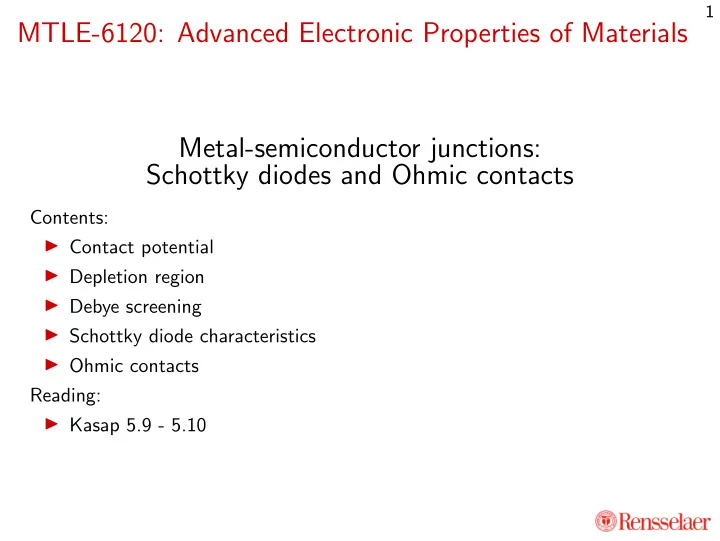

1 MTLE-6120: Advanced Electronic Properties of Materials Metal-semiconductor junctions: Schottky diodes and Ohmic contacts Contents: ◮ Contact potential ◮ Depletion region ◮ Debye screening ◮ Schottky diode characteristics ◮ Ohmic contacts Reading: ◮ Kasap 5.9 - 5.10
2 Metal-semiconductor contact potential Metal Semiconductor Metal Semiconductor ◮ Fermi levels relative to vacuum ( Φ ) not in same position ◮ Distinction for semiconductor: Φ � = work function ◮ Consider case when metal level below n -type semiconductor ◮ Fermi levels line up for equilibrium ◮ Electron transfer to metal in current example ◮ Schottky barrier height Φ B = Φ M − χ ◮ Contact potential: V 0 = Φ M − Φ n
3 Depletion region + + + - -- Metal 1 Metal 2 Metal Semiconductor ◮ Region of semiconductor near interface where charge transfer occurs ◮ Number of charge carriers reduce, hence depletion region ◮ In metal-metal case, bands on both sides respond ◮ In metal-semiconductor case, only semiconductor responds: why?
4 Debye screening ◮ Poisson equation for variation of electrostatic potential: r ) = − ρ ( � r ) ∇ 2 φ ( � ǫ 0 ◮ Charge density ρ ( � r ) includes external and bound charge ◮ Previously considered bound charge due to � P response to � E = ∇ φ ◮ What if material responds directly to potential as ρ = ρ ( φ ) ? ◮ Specifically consider small change from neutral potential φ 0 , r ) ≈ ρ ′ ( φ 0 ) ( φ ( � ρ ( � r ) − φ 0 ) ◮ Poisson equation becomes (using ǫ to account for dipolar reponse): ∇ 2 ( φ − φ 0 ) − − ρ ′ ( φ 0 ) ( φ − φ 0 ) = 0 ǫ with 1D solutions of the form φ ( x ) = φ 0 + e ± x/λ D � where λ D = ǫ/ ( − ρ ′ ( φ 0 )) is the Debye screening length
5 Debye screening length ◮ λ D = � ǫ/ ( − ρ ′ ( φ 0 )) : length scale over which potential restores to neutral ◮ Depletion region non-neutral → becomes neutral over λ D length scale ◮ Therefore width of depletion region ∼ λ D ◮ In metals, − ρ ′ ( φ 0 ) = e 2 g ( E F ) � 8 . 85 × 10 − 12 F / m (1 . 6 × 10 − 19 C) 2 · 10 47 J -1 m -3 ∼ 0 . 6 ˚ ◮ Typical λ D ∼ A ◮ Metals restore potential within an atomic layer! ◮ In semiconductors, − ρ ′ ( φ 0 ) = e 2 n maj / ( k B T ) , where n maj ≈ N a/d = majority carrier density (larger of n, p ) ◮ For 10 14 /cm 3 doped Si at room temperature, λ D ∼ 400 nm ◮ For 10 18 /cm 3 doped Si at room temperature, λ D ∼ 4 nm ◮ In all cases, λ D ∝ n − 1 / 2 , where n = free carrier density ◮ λ D in metals ≪ in semiconductors ⇒ depletion region entirely in semiconductor!
6 Applied bias Metal Semiconductor Metal Semiconductor ◮ Neutral case: band bending in semiconductor = contact potential V 0 ◮ Apply potential bias: change band bending in semiconductor ◮ Forward bias ≡ reduce band bending to V 0 − V ◮ Rate of electrons M → SC ∝ exp − φ B k B T ◮ Rate of electrons SC → M ∝ exp − e ( V 0 − V ) k B T
7 Schottky diode: I − V characteristics ◮ Net current density j = j 2 exp − e ( V 0 − V ) − j 1 exp − φ B k B T k B T ◮ At equilbrium V = 0 , j = 0 ⇒ j 2 exp − eV 0 k B T = j 1 exp − φ B k B T = j 0 (say) ◮ Therefore: � exp eV � j = j 0 k B T − 1 ◮ Exponentially increasing current in forward bias ( V > 0 ) ◮ Current saturates to − j 0 in reverse bias ◮ j 0 is given by Richardson-Dushman equation, just different B e !
8 Schottky photovoltaic devices Metal Semiconductor ◮ Contact potential ⇒ built-in field at interface ◮ Photon absorption → e - h pair, separated by field ◮ In n -type junction, e relaxes to band edge and driven into bulk SC ◮ h recombines at interface (met by e current in metal) ◮ Below band-gap, interfacial generation also possible
9 Ohmic contact Metal Semiconductor Metal Semiconductor ◮ Similar geometry to Schottky diode, but different level alignment ◮ Consider metal Fermi level lines up inside conduction band (or analogously for p -type material, inside valence band) ◮ Bands bend in opposite direction to equalize Fermi levels ◮ No barrier Φ B any more, electrons free to flow ◮ j ( V ) dominated by linear resistance of bulk semiconductor ◮ I - V follows Ohm’s law ⇒ Ohmic contact
10 Peltier effect in Ohmic contacts ◮ Electrons flowing to the left pick up energy E c − E F ◮ Electrons flowing to the right lose energy E c − E F ◮ Energy drawn/dissipated from/as thermal energy at junction ◮ Combine p and n -type junctions to get cooling in same metal ◮ Reverse operation: thermoelectric generator (heat to electricity) Metal Semiconductor
Recommend
More recommend